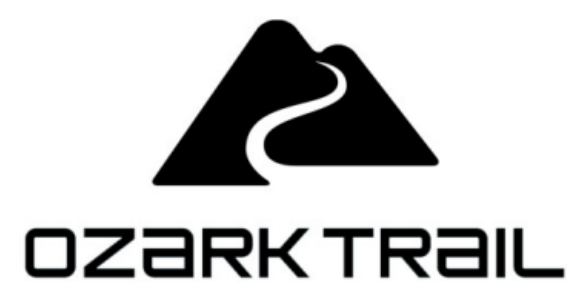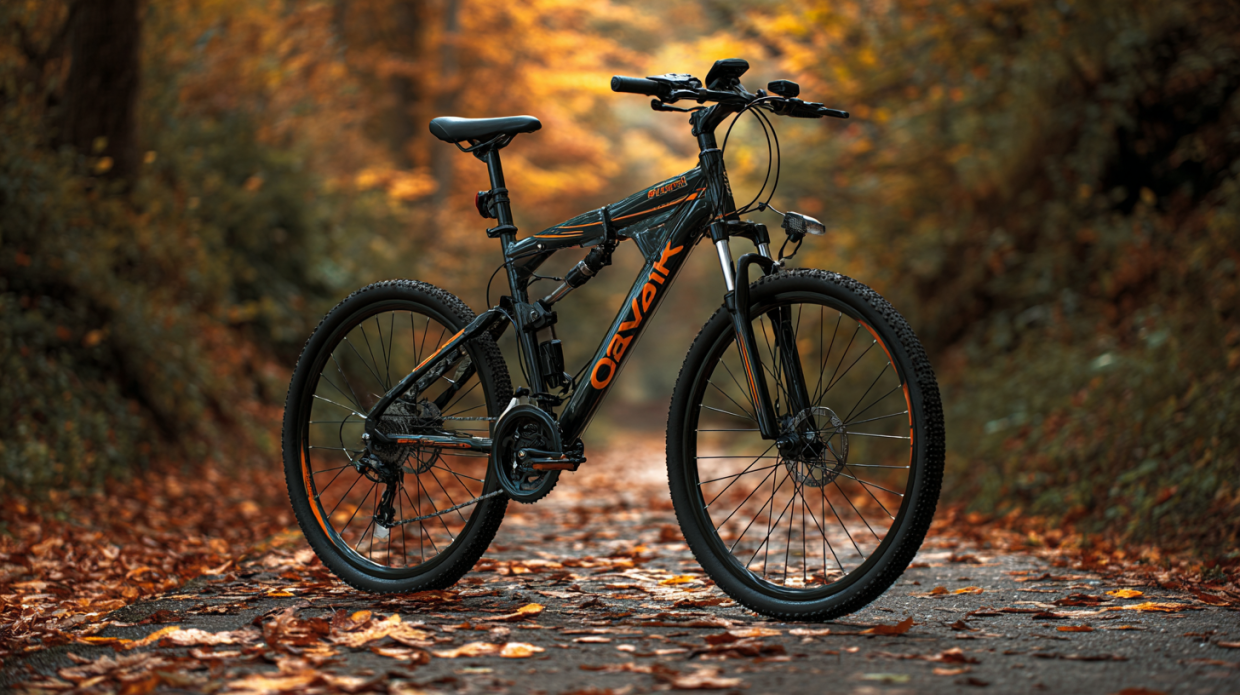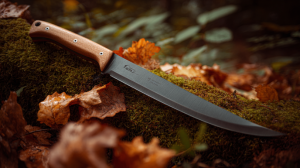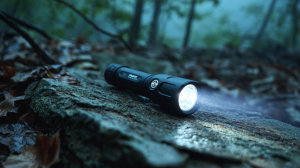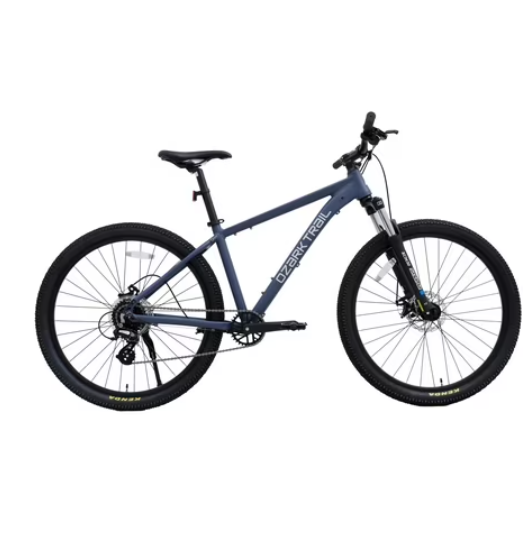
27.5″ Ozark Trail M.2 Ridge Mountain Bike, Medium Frame, Fits Riders 5’3″ – 5’8″, Blue, Adult, Unisex
- Frame: Aluminum Alloy, tapered head tube
- Fork: XCM30 aluminum single-cornw suspension fork, 100mm travel
- Shifter: Shimano 8-Speed
- Rear Derailleur: Shimano Altus
- Crankset: 32T; 165mm length; narrow-wide chainring
- Bottom Bracket: NECO B910 Sealed bearing
- Cassette: Shimano CS-HG200; 12T-32T
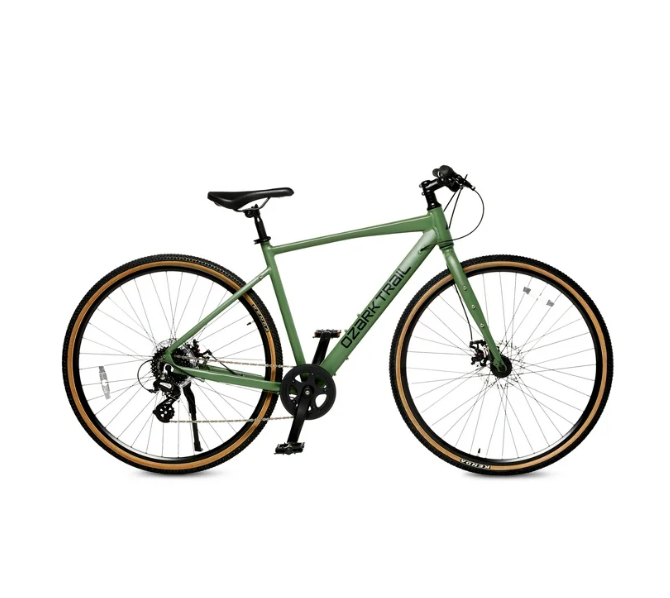
Ozark Trail 700C G.1 Explorer Flat Bar Gravel Bike, Medium Frame, Fits Riders 5’5″ – 5’10”, Green, Adult, Unisex
- Frame: 6061 Aluminum Gravel bike with nutserts, Integrated Frame Mounts
- Fork: Steel front fork with nutserts, Quick Release
- Shifter: Shimano Altus 1*8 speed trigger
- Rear Derailleur: Shimano Altus 8 speed SL-M315-8R
- Cassette: 11-32T, 8 speed
- Crank: 175mm length
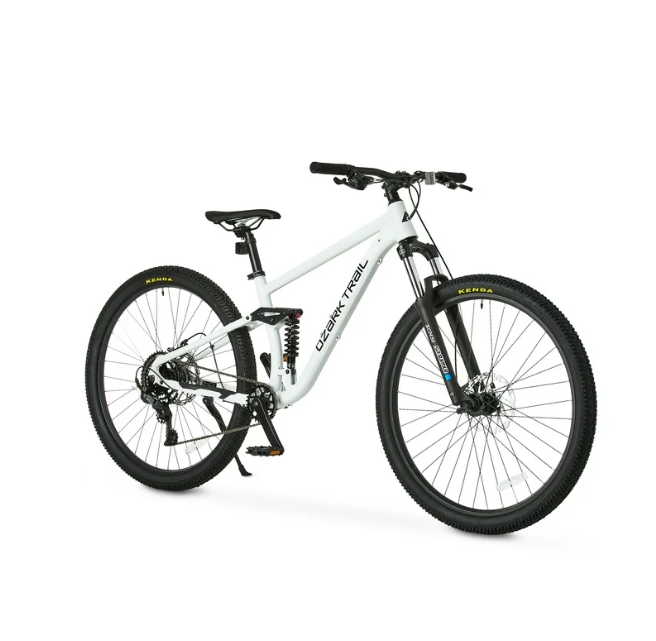
Ozark Trail FS.2 Slalom Full Suspension Mountain Bike, 29″ Wheels, Medium Frame, Fits Riders 5’6″ – 5’9″, Off-White, Adult
- Frame: Full aluminum alloy; Horst-Link design; tapered head tube; dropper post ready
- Fork: SR Suntour XCM30 120mm travel suspension
- Rear Shock: Kindshock 185mm*48mm coil spring with adjustable oil damping
- Frame Size: Medium
- Shifter & Rear Derailleur: Shimano Cues 9 Speed ARDU4000GS
- Crank: 170mm length; 30T, narrow-wide
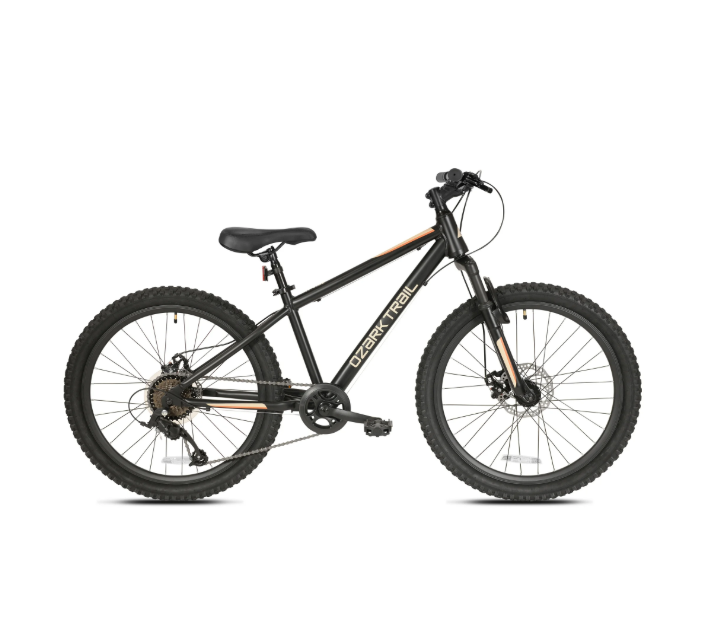
24″ Ozark Trail Vibe Mountain Bicycle, 8 Speed, Black, Fits Riders 4’6″ – 5’6″, Teen
- Ozark Trail 24″ Youth Vibe Aluminum Mountain Bicycle, 8 Speeds, Front Suspension, Dual Disc Brakes, Black
- Lightweight aluminum hardtail frame with a tapered headtube
- Front Suspension
- 24″ x 2.3″ Tires / Schrader valve tube
- Handlebar-mounted quick trigger shifters
- Front suspension fork
Discovering whether these affordable bikes can truly deliver the outdoor experience you’re seeking
When the open trail beckons and your bank account whispers caution, Ozark Trail bikes emerge as a compelling middle ground between adventure and affordability. Named after the rugged mountain region that spans Missouri and Arkansas, this Walmart-exclusive brand has carved out a unique niche in the cycling world, promising outdoor enthusiasts the chance to explore without breaking the bank.
But can a budget-friendly bicycle truly handle the demands of serious cycling? The answer, like the winding trails these bikes are meant to traverse, is more complex than it first appears. Whether you’re a weekend warrior seeking mountain adventures or a daily commuter looking for reliable transportation, understanding what Ozark Trail bikes offer—and what they don’t—is crucial to making an informed decision.
Are Ozark Trail Bikes Good for Mountain Biking?
The question that echoes through cycling forums and outdoor gear discussions centers on whether Ozark Trail bikes can handle legitimate mountain biking adventures. The reality is nuanced and depends heavily on your definition of mountain biking and your skill level.
For beginners venturing onto well-maintained trails and gentle inclines, Ozark Trail bikes can provide an adequate introduction to off-road cycling. The basic suspension systems found on many models offer enough cushioning for moderate bumps and roots, while the frame geometry provides reasonable stability for novice riders. However, experienced mountain bikers accustomed to technical terrain, steep descents, and aggressive riding styles will likely find these bikes limiting.
The components on Ozark Trail bikes are designed with cost-effectiveness in mind rather than performance optimization. While this makes them accessible to a broader audience, it also means that the derailleur systems, brake mechanisms, and suspension components may struggle under the intense demands of serious mountain biking. The steel frames, while durable, add weight that can become noticeable during climbs and extended rides.
That said, many cycling enthusiasts have successfully used Ozark Trail bikes for recreational trail riding, light cross-country adventures, and family outings on moderate terrain. The key is setting appropriate expectations and understanding that these bikes excel in providing affordable access to outdoor cycling rather than competing with specialized mountain bike brands.
Understanding the Ozark Trail Bike Lineup
Ozark Trail bikes offer a surprisingly diverse range of options designed to meet various cycling needs and preferences. The brand’s portfolio spans several categories, each targeting different rider demographics and use cases.
The mountain bike category represents the core of the Ozark Trail bikes collection, featuring models with front suspension, knobby tires, and frame designs optimized for off-road use. These typically come in both hardtail configurations with front suspension only and full-suspension models for riders seeking maximum comfort on rough terrain. The frame sizes generally range from 24-inch wheels for younger riders up to 29-inch wheels for adults seeking improved rollover capability.
Hybrid bikes form another significant segment of the Ozark Trail bikes lineup, blending mountain bike durability with road bike efficiency. These models feature smoother tires suitable for paved surfaces while maintaining the upright riding position and robust construction that makes them versatile for various terrains. The hybrid approach makes these bikes particularly appealing for commuters who encounter mixed surface conditions during their daily rides.
The brand also produces traditional road bikes designed for pavement cycling, complete with drop handlebars and narrower tires optimized for speed and efficiency. While these models may not offer the premium components found in high-end road bikes, they provide an entry point for riders interested in road cycling without the significant financial investment typically required.
For families and recreational riders, Ozark Trail bikes include comfort models with step-through frames, wide saddles, and upright riding positions designed to maximize ease of use and rider comfort. These bikes prioritize accessibility and comfort over performance, making them ideal for casual neighborhood rides and leisurely outdoor excursions.
Where to Purchase Your Ozark Trail Bike
The distribution strategy for Ozark Trail bikes is straightforward yet somewhat limiting compared to traditional bike brands. As a Walmart exclusive brand, these bicycles are primarily available through Walmart stores and the company’s online platform. This exclusive arrangement keeps costs down by eliminating traditional bike shop markups but also limits purchasing options for consumers.
Physical Walmart locations with bike departments typically stock a selection of Ozark Trail bikes, allowing potential buyers to examine the bikes in person, test the fit, and assess build quality before purchasing. The in-store experience also provides access to Walmart’s bike assembly services, which can be valuable for customers who prefer professional assembly over DIY approaches.
The online Walmart platform offers the complete range of Ozark Trail bikes, often with more size and color options than individual stores can stock. Online purchasing provides convenient home delivery, though buyers should be prepared for some assembly requirements upon delivery. The website also features customer reviews and detailed specifications that can aid in the decision-making process.
Third-party sellers occasionally offer Ozark Trail bikes through platforms like eBay or Facebook Marketplace, particularly for discontinued models or used bikes. However, buyers should exercise caution when purchasing from unofficial sources, as warranty coverage and return policies may not apply to these transactions.
The exclusive Walmart distribution model means that traditional bike shops do not carry Ozark Trail bikes, which can be both an advantage and a disadvantage. While this keeps prices low, it also means that buyers cannot access the expertise and fitting services that specialized bike retailers typically provide.
Cost Analysis and Value Proposition
The pricing structure of Ozark Trail bikes represents their most compelling selling point, with models typically ranging from under $200 for basic configurations to around $400 for more feature-rich options. This pricing strategy positions these bikes significantly below comparable offerings from traditional bike manufacturers, making cycling accessible to budget-conscious consumers.
Entry-level Ozark Trail bikes often start around $150-$200, featuring basic components and simple frame designs suitable for casual riding and light recreational use. These models typically include front suspension on mountain bike variants, basic derailleur systems, and standard safety features like reflectors and kickstands.
Mid-range options in the Ozark Trail bikes lineup, priced between $250-$350, generally offer improved components, better suspension systems, and more sophisticated frame designs. These bikes often feature aluminum frames instead of steel, upgraded shifter systems, and enhanced braking mechanisms that provide better performance and durability.
The premium Ozark Trail bikes models, while still budget-friendly by industry standards, can reach $400-$500 and include features like full suspension, disc brakes, and higher-quality component groups. Even at these price points, Ozark Trail bikes remain significantly less expensive than comparable models from established cycling brands.
When evaluating the value proposition, it’s important to consider what you’re getting for the price. Ozark Trail bikes excel at providing basic cycling functionality at accessible price points, making them ideal for occasional riders, families with multiple children needing bikes, or individuals testing their interest in cycling before making larger investments.
However, the cost savings come with trade-offs in component quality, long-term durability, and performance optimization. Riders who plan to cycle frequently or tackle challenging terrain may find that investing in higher-quality bikes from traditional manufacturers provides better long-term value despite the higher upfront cost.
Beginner-Friendly Features and Considerations
Ozark Trail bikes shine particularly bright when it comes to serving beginner cyclists, offering several features and characteristics that make them ideal for riders just starting their cycling journey. The approachable price point removes a significant barrier to entry, allowing new cyclists to explore the hobby without substantial financial risk.
The frame geometry on most Ozark Trail bikes emphasizes stability and comfort over aggressive performance, creating a riding experience that feels secure and predictable for inexperienced riders. The upright riding position common across the range reduces strain on the back and neck while providing better visibility of the surrounding environment, both crucial factors for building confidence in new cyclists.
Assembly and maintenance requirements for Ozark Trail bikes are generally straightforward, with basic tools and mechanical knowledge sufficient for most adjustments and repairs. This accessibility helps beginners develop mechanical skills and understanding of their bikes without requiring specialized tools or advanced technical knowledge.
The component specifications on Ozark Trail bikes are designed for ease of use rather than complexity. Shifting systems typically feature simple thumb shifters or twist grips that are intuitive for beginners to operate, while the gear ranges are optimized for versatility rather than specialized performance applications.
For parents introducing children to cycling, Ozark Trail bikes offer particular advantages. The affordable pricing makes it feasible to purchase multiple bikes for growing families, while the basic feature sets focus on essential cycling skills without overwhelming young riders with complex systems they’re not ready to utilize.
However, beginners should be aware that the entry-level nature of Ozark Trail bikes means that as skills and enthusiasm develop, they may quickly outgrow the performance limitations of these bikes. This progression is natural and can be viewed as a positive sign of developing cycling passion rather than a negative aspect of the bikes themselves.
Durability and Off-Road Performance Assessment
The durability profile of Ozark Trail bikes presents a mixed picture that largely depends on usage patterns and maintenance practices. For their intended market segment and price point, these bikes demonstrate reasonable longevity when used within their design parameters, though they may struggle under extreme conditions or heavy use.
Frame construction on Ozark Trail bikes typically utilizes steel or aluminum materials, both of which offer adequate strength for recreational cycling. Steel frames provide good impact resistance and can handle moderate abuse, though they add weight that may become noticeable during longer rides or climbs. Aluminum frames found on higher-end models reduce weight but may be more susceptible to damage from severe impacts.
The component durability varies significantly across the Ozark Trail bikes range, with entry-level models featuring basic parts that may require more frequent adjustment and replacement. Derailleur systems, while functional, may not maintain precise shifting under heavy use, and brake systems may require more frequent cable adjustments and pad replacements than higher-quality alternatives.
Off-road performance capabilities are adequate for moderate trail conditions, fire roads, and well-maintained single-track paths. The suspension systems provide basic shock absorption for roots, rocks, and small drops, though they lack the sophistication and adjustability found on specialized mountain bikes. Riders should expect some limitations when encountering technical terrain, steep descents, or aggressive riding conditions.
Tire quality on Ozark Trail bikes varies but generally provides sufficient traction for typical off-road conditions. The tread patterns are designed for versatility rather than specialized performance, making them suitable for mixed terrain riding but potentially limiting on specific surface types like loose sand or wet rocks.
Regular maintenance becomes particularly important for maximizing the durability of Ozark Trail bikes, as the entry-level components benefit from frequent lubrication, adjustment, and inspection. Riders who stay on top of basic maintenance tasks can significantly extend the useful life of their bikes and maintain better performance over time.
Weight Capacity and Sizing Considerations
Understanding the weight limitations and sizing options for Ozark Trail bikes is crucial for ensuring safe and comfortable riding experiences. The manufacturer typically specifies weight limits ranging from 250 to 300 pounds for most adult models, though these limits should be considered conservative guidelines rather than absolute maximums.
Frame sizing in the Ozark Trail bikes lineup generally follows industry standards, with options typically available in small, medium, large, and extra-large configurations. However, the specific geometry and fit characteristics may differ from traditional bike manufacturers, making it important for riders to carefully consider their body proportions and riding preferences when selecting a size.
The steel frames common in many Ozark Trail bikes models provide good weight-bearing capacity and can handle heavier riders without the flex or stress concerns that might arise with ultra-lightweight materials. However, riders approaching or exceeding the specified weight limits should pay particular attention to wheel and component specifications, as these elements may represent the limiting factors for weight capacity.
Sizing charts provided by the manufacturer offer general guidance, but individual proportions, flexibility, and riding style preferences can significantly impact the ideal bike size. Riders with longer legs relative to their torso, for example, may prefer a larger frame size even if their overall height suggests a smaller option.
The adjustability features on Ozark Trail bikes are somewhat limited compared to higher-end models, with basic seat height and handlebar position adjustments available on most models. This limited adjustability makes proper initial sizing more critical, as fine-tuning options may be restricted once the bike is purchased.
For families considering multiple Ozark Trail bikes purchases, the consistent sizing approach across the brand can simplify the selection process and make it easier to choose appropriate models for different family members based on established size preferences.
Electric Bike Options and Innovations
The electric bike segment represents an emerging area for Ozark Trail bikes, with the brand beginning to explore e-bike options to meet growing consumer demand for electric-assisted cycling. While the selection remains limited compared to traditional pedal-powered models, the available options demonstrate the brand’s commitment to providing affordable access to emerging cycling technologies.
Current Ozark Trail bikes electric models typically feature basic electric assist systems with modest battery capacities and simple control interfaces. These systems are designed to provide assistance for casual riding and commuting rather than high-performance applications, aligning with the brand’s overall philosophy of accessible cycling solutions.
Battery range on Ozark Trail bikes electric models generally falls in the 20-30 mile range under optimal conditions, which is adequate for most recreational riding and short commuting applications. The batteries are typically removable for convenient charging and security, though the charging systems are basic compared to premium e-bike offerings.
Motor placement and power output on Ozark Trail bikes electric models tend toward hub-mounted systems with moderate assistance levels. These configurations provide smooth power delivery and simple operation while keeping costs reasonable compared to more sophisticated mid-drive systems found on premium e-bikes.
The control systems on Ozark Trail bikes electric models emphasize simplicity and ease of use, with basic displays showing battery level and assistance mode. Advanced features like smartphone connectivity, GPS integration, or sophisticated ride metrics are generally not available, keeping the focus on essential electric assistance functionality.
As the e-bike market continues to evolve and costs decrease, Ozark Trail bikes is likely to expand their electric offerings, potentially introducing more sophisticated systems while maintaining their commitment to affordable pricing. Current electric models represent a good entry point for riders curious about e-bike technology without the substantial investment required for premium electric bicycles.
Assembly Requirements and Setup Process
The assembly process for Ozark Trail bikes is designed to balance cost savings with user accessibility, though some mechanical aptitude is beneficial for optimal results. Most models arrive partially assembled, requiring basic tool skills and attention to detail to complete the setup process safely and effectively.
Typical assembly requirements for Ozark Trail bikes include installing the front wheel, handlebars, pedals, and seat, along with basic adjustments to brakes and derailleurs. The instruction manuals provide step-by-step guidance, though the quality and clarity of these instructions can vary between models and production runs.
Essential tools for Ozark Trail bikes assembly typically include basic hex keys, adjustable wrenches, and screwdrivers—tools that most households already possess or can acquire inexpensively. Some models may require specialized tools like bike-specific wrenches, though these requirements are generally minimal and clearly specified in the assembly instructions.
Safety considerations during assembly are paramount, particularly for brake and steering components that directly impact rider safety. Ozark Trail bikes assembly requires careful attention to torque specifications and proper tightening procedures to ensure all safety-critical components are secure and functional.
Walmart stores often provide assembly services for Ozark Trail bikes purchased through their locations, which can be valuable for customers lacking the tools, space, or confidence to complete assembly themselves. These services typically include basic safety checks and adjustments to ensure the bike is ready for safe operation upon pickup.
For DIY assembly enthusiasts, taking time to properly understand each step and double-check all connections and adjustments is crucial. Many common issues with Ozark Trail bikes can be traced to improper assembly or inadequate initial adjustments, making careful setup essential for optimal performance and safety.
Post-assembly break-in procedures are important for Ozark Trail bikes, as cables may stretch and components may settle during initial use. Planning for minor adjustments after the first few rides helps maintain optimal performance and extends component life.
Frame Materials and Construction Quality
The construction approach for Ozark Trail bikes reflects the brand’s commitment to providing functional bicycles at accessible price points, with material choices and manufacturing processes optimized for cost-effectiveness while maintaining adequate quality standards for recreational cycling applications.
Steel remains a primary frame material for many Ozark Trail bikes models, particularly in the entry-level and mid-range categories. Steel offers several advantages for budget-conscious manufacturing, including excellent durability, repairability, and resistance to fatigue failure. The material also provides a comfortable ride quality by naturally dampening road vibrations and small impacts.
Aluminum frame construction appears in higher-end Ozark Trail bikes models, offering weight savings and corrosion resistance compared to steel alternatives. While aluminum frames may not provide the same natural vibration dampening as steel, they offer improved climbing performance and easier handling due to reduced overall bike weight.
Welding quality on Ozark Trail bikes frames generally meets basic safety and durability standards, though the finish quality may not match premium bicycle manufacturers. Functional welds provide adequate strength for intended use cases, while cosmetic details like weld cleanup and frame alignment may show evidence of cost-conscious manufacturing approaches.
Frame geometry across the Ozark Trail bikes range tends toward comfortable, stable configurations rather than aggressive performance-oriented designs. This approach makes the bikes more accessible to casual riders while potentially limiting appeal to experienced cyclists seeking responsive handling characteristics.
Paint and finishing processes on Ozark Trail bikes provide basic protection and visual appeal, though long-term durability may be limited compared to premium finishes. Regular cleaning and basic maintenance can help preserve frame appearance and prevent corrosion, particularly important for riders in harsh environmental conditions.
Component mounting and frame features generally include standard threading and attachment points compatible with common bicycle accessories and replacement parts. This standardization helps ensure that riders can maintain and upgrade their Ozark Trail bikes using readily available components and tools.
Commuting Viability and Urban Use
For urban commuters seeking affordable transportation alternatives, Ozark Trail bikes present both opportunities and limitations that vary based on specific commuting requirements and local conditions. The budget-friendly pricing makes cycling accessible to commuters who might otherwise be priced out of reliable transportation options, while the basic feature sets provide essential functionality for urban navigation.
Hybrid models in the Ozark Trail bikes lineup often serve commuters particularly well, offering a balance of durability, comfort, and efficiency suitable for mixed urban terrain. The upright riding position provides good visibility in traffic situations, while the robust construction can handle the daily demands of commuting use.
However, commuters should carefully consider their specific route requirements and usage patterns when evaluating Ozark Trail bikes for transportation use. Riders facing long distances, significant elevation changes, or challenging weather conditions may find the entry-level components limiting for daily use.
Security considerations become particularly important for commuting applications, as Ozark Trail bikes may be attractive targets for theft due to their recognizable appearance and widespread availability. Investing in quality locks and secure parking arrangements becomes essential for protecting these affordable transportation investments.
Maintenance requirements for commuting use may be higher than recreational cycling, as daily exposure to urban conditions, weather, and increased mileage can accelerate component wear. Commuters should budget time and resources for regular maintenance to ensure reliable transportation service.
Weather resistance on Ozark Trail bikes varies by model but generally requires additional consideration for year-round commuting. Basic fender and lighting provisions may need supplementation for optimal all-weather performance, while component protection may require aftermarket solutions.
Warranty Coverage and Customer Support
Understanding the warranty and support structure for Ozark Trail bikes helps set appropriate expectations for long-term ownership and potential issue resolution. The warranty coverage typically reflects the budget-oriented nature of these bikes while providing basic protection against manufacturing defects and premature failures.
Standard warranty terms for Ozark Trail bikes generally cover frame defects and manufacturing issues for a limited period, typically ranging from 90 days to one year depending on the specific model and component. This coverage is more limited than premium bicycle brands but remains reasonable given the significant price differences involved.
Component warranties may vary based on the specific parts involved, with some elements like wheels, drivetrain components, and accessories potentially carrying different coverage terms than the main frame. Understanding these distinctions helps riders know what protections are available and for how long.
Customer support for Ozark Trail bikes operates primarily through Walmart’s existing customer service infrastructure, which provides convenient access but may lack the specialized cycling knowledge available through traditional bike shops. Support representatives can typically assist with warranty claims, assembly questions, and basic troubleshooting guidance.
Replacement parts availability represents both an advantage and challenge for Ozark Trail bikes owners. Common components like tires, tubes, and basic hardware are readily available through multiple sources, while specialized parts may require sourcing through Walmart or compatible alternatives from other manufacturers.
Documentation and support materials for Ozark Trail bikes are generally adequate for basic maintenance and troubleshooting, though they may lack the depth and detail found with premium bicycle brands. Online resources, user communities, and general cycling maintenance guides can supplement official documentation for more complex issues.
Common Issues and Troubleshooting
Like any mechanical device, Ozark Trail bikes experience predictable patterns of issues and maintenance requirements that owners can anticipate and address proactively. Understanding these common challenges helps riders maintain their bikes more effectively and avoid frustrating breakdowns.
Shifting problems represent one of the most frequent issues with Ozark Trail bikes, often manifesting as difficulty changing gears, chain skipping, or imprecise gear changes. These problems typically stem from cable stretch, derailleur adjustment needs, or component wear rather than fundamental design flaws.
Brake performance issues, including squealing, reduced stopping power, or inconsistent feel, commonly develop over time as brake pads wear and cables stretch. Regular inspection and adjustment of brake systems helps maintain safe operation and prevents more serious problems from developing.
Wheel and tire issues, including spoke tension problems, rim wear, and premature tire wear, may occur more frequently on Ozark Trail bikes due to the entry-level wheel components. Regular inspection and prompt attention to developing problems can prevent more costly repairs and safety issues.
Assembly-related problems often appear within the first few weeks of ownership, as initial cable stretch and component settling occurs. Many apparent “defects” are actually normal break-in phenomena that can be addressed through basic adjustments and fine-tuning.
Chain and drivetrain wear patterns may develop more quickly on Ozark Trail bikes compared to premium alternatives, particularly under heavy use or poor maintenance conditions. Regular cleaning, lubrication, and inspection help maximize component life and maintain smooth operation.
Suspension issues, where applicable, typically involve gradual loss of performance rather than sudden failure. Basic maintenance like cleaning and lubrication can often restore function, while more serious problems may require professional attention or component replacement.
Maintenance Requirements and Ease of Service
The maintenance approach for Ozark Trail bikes emphasizes accessibility and simplicity, with basic tools and skills sufficient for most routine care requirements. This user-friendly maintenance profile makes these bikes particularly suitable for riders who want to develop mechanical skills or prefer handling their own bike care.
Routine maintenance tasks for Ozark Trail bikes include regular cleaning, chain lubrication, tire pressure checks, and basic component inspection. These fundamental practices significantly impact performance and longevity while requiring minimal time investment and basic tools.
Seasonal maintenance requirements may include more comprehensive tasks like cable lubrication, brake adjustment, and drivetrain cleaning. Ozark Trail bikes respond well to regular attention, with consistent maintenance preventing many common problems and extending component life.
Tool requirements for Ozark Trail bikes maintenance remain basic and affordable, typically including hex keys, screwdrivers, tire levers, and basic lubricants. This minimal tool investment makes self-maintenance accessible to most riders without significant financial barriers.
Professional service options for Ozark Trail bikes are available through most local bike shops, though some shops may have policies regarding work on budget bikes or non-standard components. Building relationships with local service providers can provide valuable resources for more complex maintenance tasks.
Replacement parts sourcing for Ozark Trail bikes benefits from the use of standard components and specifications compatible with widely available alternatives. This compatibility means that riders aren’t locked into proprietary parts systems and can often find affordable replacement options from multiple sources.
Gear Adjustment and Fine-Tuning
Proper gear adjustment represents one of the most important maintenance skills for Ozark Trail bikes owners, as shifting performance directly impacts riding enjoyment and component longevity. The derailleur systems used on these bikes respond well to basic adjustments when performed correctly and systematically.
Initial gear adjustment on Ozark Trail bikes often requires attention within the first few weeks of ownership, as new cables stretch and components settle into their operating positions. This break-in period is normal and shouldn’t be considered a defect or quality issue.
Basic derailleur adjustment involves understanding limit screws, cable tension, and B-tension settings that control how the derailleur moves and positions the chain. Ozark Trail bikes use standard adjustment procedures compatible with general cycling maintenance guides and tutorials.
Cable maintenance plays a crucial role in shifting performance, with regular lubrication and inspection preventing many common problems. The cable systems on Ozark Trail bikes are straightforward and respond well to basic care and attention.
Troubleshooting shifting problems typically involves systematic evaluation of cable tension, derailleur alignment, and component wear. Many apparent shifting issues can be resolved through basic adjustments rather than component replacement, making problem-solving skills valuable for owners.
Professional adjustment services are available through most bike shops and can be particularly valuable for riders learning maintenance skills or dealing with complex adjustment issues. The investment in professional service can also provide learning opportunities for future self-maintenance.
Replacement Parts Availability and Compatibility
The parts ecosystem for Ozark Trail bikes benefits from the use of standard bicycle components and specifications, making replacement parts relatively accessible through multiple channels. This standardization helps ensure that riders can maintain their bikes long-term without being locked into proprietary parts systems.
Common wear items like brake pads, chains, tires, and tubes are readily available through bike shops, online retailers, and general merchandise stores. The standard specifications used on Ozark Trail bikes mean that riders have multiple sourcing options for these essential maintenance items.
Drivetrain components including derailleurs, shifters, and cassettes typically use standard specifications compatible with products from major component manufacturers. This compatibility provides upgrade paths for riders seeking improved performance while maintaining reasonable costs.
Frame-specific components like seat posts, stems, and bottom brackets generally follow industry standards, though some models may use less common specifications that require careful attention when sourcing replacements. Checking specific measurements and threading before ordering parts prevents compatibility issues.
Online resources and compatibility databases can help Ozark Trail bikes owners identify appropriate replacement parts and upgrade options. Many cycling websites and forums provide specific guidance for budget bike maintenance and improvement projects.
Local bike shop relationships can be valuable for parts sourcing and compatibility advice, even if the shop didn’t originally sell the bike. Many shops are willing to work on Ozark Trail bikes and can provide expert guidance on parts selection and installation.
Accessory Compatibility and Customization Options
Ozark Trail bikes generally accommodate standard bicycle accessories and customization options, thanks to the use of conventional mounting points and specifications throughout most models. This compatibility opens up possibilities for personalizing and improving the bikes according to individual needs and preferences.
Lighting systems, water bottle cages, and basic safety accessories typically mount easily to Ozark Trail bikes using standard clamps and mounting points. These additions can significantly enhance the functionality and safety of the bikes for various riding applications.
Fender and rack mounting options vary by model but generally follow industry standards where mounting points are provided. These accessories can transform Ozark Trail bikes into more practical transportation tools, particularly for commuting and utility cycling applications.
Comfort upgrades like improved saddles, ergonomic grips, and handlebar accessories are typically straightforward to install and can significantly improve the riding experience. These relatively inexpensive modifications often provide substantial improvements in comfort and usability.
Performance upgrades present both opportunities and limitations for Ozark Trail bikes owners. While many components can be upgraded to improve performance, the entry-level nature of the frames and some components may limit the practical benefits of expensive upgrades.
Storage solutions including frame bags, handlebar bags, and rear panniers generally mount successfully to Ozark Trail bikes with appropriate hardware. These additions can expand the bikes’ utility for touring, commuting, and recreational riding applications.
Long-Distance Riding Comfort Assessment
The comfort characteristics of Ozark Trail bikes for extended riding sessions reflect their design priorities and component specifications, with some models better suited for long distances than others. Understanding these comfort factors helps riders set appropriate expectations and make informed decisions about route planning and bike selection.
Riding position on most Ozark Trail bikes tends toward upright and comfortable configurations rather than aggressive performance orientations. This approach reduces strain on the back, neck, and wrists during longer rides, though it may compromise aerodynamic efficiency compared to more sport-oriented bicycles.
Saddle comfort varies significantly across the Ozark Trail bikes range, with some models featuring basic seats that may become uncomfortable during extended use. Upgrading to a higher-quality saddle represents one of the most impactful comfort improvements available for these bikes.
Vibration dampening characteristics depend largely on frame material and tire selection, with steel frames generally providing better shock absorption than aluminum alternatives. Tire pressure optimization and width selection can also significantly impact comfort on various surface types.
Handlebar and grip design influences comfort during long rides, particularly regarding hand and wrist positioning. Ozark Trail bikes typically feature standard grip interfaces that allow for easy upgrades to more ergonomic alternatives if needed.
Gear range limitations on some Ozark Trail bikes models may impact comfort on challenging terrain, as inadequate low gearing can force riders to work harder than necessary on climbs. Understanding the gear ratios and local terrain helps determine suitability for specific riding applications.
Comparing Ozark Trail to Established Brands
When evaluating Ozark Trail bikes against established cycling brands like Schwinn, Trek, or Specialized, the comparison reveals distinct trade-offs between cost, performance, and long-term value that potential buyers should carefully consider based on their specific needs and cycling goals.
Price differential represents the most obvious distinction, with Ozark Trail bikes typically costing 30-60% less than comparable models from traditional manufacturers. This significant savings opens cycling access to budget-conscious consumers while requiring compromises in component quality and performance optimization.
Component specifications show clear differences between Ozark Trail bikes and premium alternatives, with established brands typically offering more sophisticated drivetrains, better suspension systems, and higher-quality finishing components. These differences translate into noticeable performance gaps for experienced riders.
Frame quality and design sophistication generally favor established brands, which invest heavily in research, development, and testing to optimize geometry, materials, and construction techniques. Ozark Trail bikes frames are functional and adequate but may lack the refined characteristics found in premium alternatives.
Warranty coverage and customer support systems typically provide more comprehensive protection and specialized expertise with traditional bike brands compared to the general retail support available for Ozark Trail bikes. This difference can be significant for riders requiring ongoing service and support.
Resale value considerations strongly favor established brands, as Ozark Trail bikes typically experience rapid depreciation and limited second-hand market demand. Riders planning to upgrade or sell their bikes should factor this depreciation into their total cost calculations.
The overall value proposition depends heavily on individual usage patterns, mechanical aptitude, and performance expectations. Ozark Trail bikes excel at providing basic cycling functionality at accessible prices, while established brands offer superior performance, durability, and support for more demanding applications.
Final Verdict: Finding Your Perfect Ride
Ozark Trail bikes occupy a unique and valuable position in the cycling marketplace, providing genuine access to outdoor recreation and transportation for riders who might otherwise be excluded by price barriers. While these bikes may not compete with premium alternatives in performance metrics, they excel in their primary mission of making cycling accessible and affordable.
The decision to choose Ozark Trail bikes should be based on realistic assessment of your cycling goals, budget constraints, and mechanical comfort level. For recreational riders, families seeking multiple bikes, and beginners exploring cycling interest, these bikes offer compelling value propositions that can open doors to lifelong cycling enjoyment.
However, serious cyclists, frequent riders, and those tackling challenging terrain will likely find Ozark Trail bikes limiting and may benefit from investing in higher-quality alternatives despite the increased cost. The key lies in honest evaluation of your needs and expectations rather than attempting to make budget bikes perform beyond their intended capabilities.
Understanding the strengths and limitations of Ozark Trail bikes enables informed decision-making and realistic expectations that can lead to satisfying cycling experiences. With proper maintenance, appropriate usage, and realistic expectations, these affordable bikes can provide years of reliable service and outdoor enjoyment.
The cycling community benefits from accessible entry points that introduce new riders to the sport, and Ozark Trail bikes serve this important role effectively. Whether these bikes represent the perfect solution for your needs depends on your specific circumstances, but they undeniably provide valuable options in an increasingly expensive recreational landscape.
